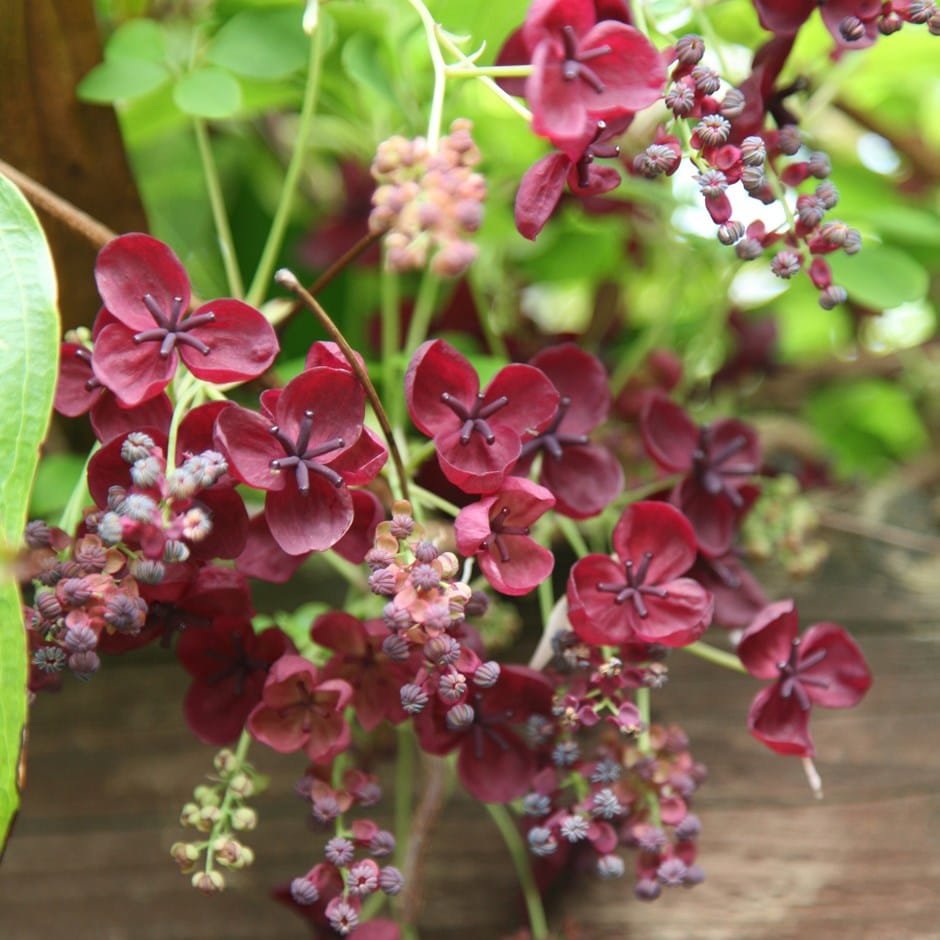
A very pretty semi-evergreen climber, with beautiful maroon-chocolate flowers that have a spicy fragrance with just a hint of vanilla. Appearing in spring, they stand out against the bright green, three-lobed leaves, which have a purple tinge in winter.
Akebia quinata is excellent for training against a wall or over a pergola, and in warmer years, this chocolate vine can produce large sausage-shaped fruits - if you have two plants of the same species that can cross-pollinate.
Akebia quinata is excellent for training against a wall or over a pergola, and in warmer years, this chocolate vine can produce large sausage-shaped fruits - if you have two plants of the same species that can cross-pollinate.
How to care for Akebia quinata:
To avoid dry conditions, and to ensure good soil contact around the rootball, we advise planting climbers at least 30cm (12in), and preferably 45-60cm (18-24in) away from the base of a wall or fence. An even larger distance should be maintained when planting climbers beside an existing tree or shrub.
To plant Akebia quinata (chocolate vine), choose a sunny spot and well-draining, fertile soil. This vigorous climber benefits from support, like a trellis, pergola, or wall, as it can grow quickly and cover large areas.
Water regularly during establishment, though once mature, it’s relatively drought-tolerant. In colder areas, a sheltered location can help protect it from frost damage. Prune as needed after flowering to control growth and shape.
To plant Akebia quinata (chocolate vine), choose a sunny spot and well-draining, fertile soil. This vigorous climber benefits from support, like a trellis, pergola, or wall, as it can grow quickly and cover large areas.
Water regularly during establishment, though once mature, it’s relatively drought-tolerant. In colder areas, a sheltered location can help protect it from frost damage. Prune as needed after flowering to control growth and shape.
Flowering period:
- Jan
- Feb
- Mar
- Apr
- May
- Jun
- Jul
- Aug
- Sep
- Oct
- Nov
- Dec
Eventual height:
10m
Eventual spread:
2m
Position:
Full sun
Rate of growth:
Average
Soil:
Moderately fertile, moist, well-drained soil
Hardiness:
Fully hardy
-
This climber is semi-evergreen, so it can lose some of its leaves in winter. In colder regions or more exposed gardens, it may lose them all, but then fresh new foliage appears again in spring.
Product options
available to order from summer
Checkout now
Delivery options (pick your preferred option at checkout)

A very pretty semi-evergreen climber, with beautiful maroon-chocolate flowers that have a spicy fragrance with just a hint of vanilla. Appearing in spring, they stand out against the bright green, three-lobed leaves, which have a purple tinge in winter.
Akebia quinata is excellent for training against a wall or over a pergola, and in warmer years, this chocolate vine can produce large sausage-shaped fruits - if you have two plants of the same species that can cross-pollinate.
Akebia quinata is excellent for training against a wall or over a pergola, and in warmer years, this chocolate vine can produce large sausage-shaped fruits - if you have two plants of the same species that can cross-pollinate.
How to care for Akebia quinata:
To avoid dry conditions, and to ensure good soil contact around the rootball, we advise planting climbers at least 30cm (12in), and preferably 45-60cm (18-24in) away from the base of a wall or fence. An even larger distance should be maintained when planting climbers beside an existing tree or shrub.
To plant Akebia quinata (chocolate vine), choose a sunny spot and well-draining, fertile soil. This vigorous climber benefits from support, like a trellis, pergola, or wall, as it can grow quickly and cover large areas.
Water regularly during establishment, though once mature, it’s relatively drought-tolerant. In colder areas, a sheltered location can help protect it from frost damage. Prune as needed after flowering to control growth and shape.
To plant Akebia quinata (chocolate vine), choose a sunny spot and well-draining, fertile soil. This vigorous climber benefits from support, like a trellis, pergola, or wall, as it can grow quickly and cover large areas.
Water regularly during establishment, though once mature, it’s relatively drought-tolerant. In colder areas, a sheltered location can help protect it from frost damage. Prune as needed after flowering to control growth and shape.
Flowering period:
- Jan
- Feb
- Mar
- Apr
- May
- Jun
- Jul
- Aug
- Sep
- Oct
- Nov
- Dec
Eventual height:
10m
Eventual spread:
2m
Position:
Full sun
Rate of growth:
Average
Soil:
Moderately fertile, moist, well-drained soil
Hardiness:
Fully hardy
-
This climber is semi-evergreen, so it can lose some of its leaves in winter. In colder regions or more exposed gardens, it may lose them all, but then fresh new foliage appears again in spring.
Product options
available to order from summer
Checkout now
